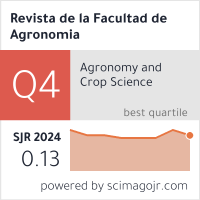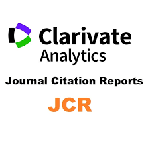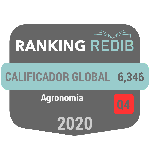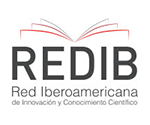Efecto de los métodos de secado en la composición fisicoquímica y la microestructura de polvos de calabaza
Resumen
Para aumentar la vida útil de las frutas y verduras, poder disfrutarlas en las cuatro estaciones y preservar su composición genética, se ha descubierto que, el secado es la mejor técnica de conservación. El objetivo de este trabajo se basa en el estudio la cinética de secado de calabaza (Curcubita maxima) mediante dos métodos de secado, a saber, secado en horno a una temperatura de 60 °C y secado en microondas a 180 W, para modelar la cinética de secado de capas delgadas de calabaza mediante cuatro modelos matemáticos (Two-Term, Modified Henderson y Pabis, Henderson Pabis y Bousselma et al.) y estudiar el efecto de los dos métodos de secado sobre las propiedades nutricionales y microestructurales de los polvos de calabaza. Los resultados mostraron que, el secado por microondas fue más rápido que, el secado en horno. Se eligieron los modelos modificados de Henderson y Pabis y de Bousselma et al., para describir adecuadamente el comportamiento del secado de las rodajas finas de calabaza secadas en horno y microondas, respectivamente, debido a un alto valor de R² y bajos valores de χ² y RMSE. La composición fisicoquímica de los dos polvos (POD y PMD) presentó diferencias significativas (p < 0,05) en cuanto a contenido de agua, pH, grados Brix, lípidos y potasio. El análisis de la composición cualitativa mediante FTIR no mostró cambios entre los dos polvos. De igual manera, la estructura estudiada mediante SEM mostró una estructura idéntica y homogénea. Estos polvos poseen elevadas propiedades nutricionales, por lo que conviene recomendar su incorporación a los alimentos.
Descargas
Citas
Adilah, A. N., Jamilah, B., Noranizan, M. A., & Hanani, Z. A. N. (2018). Utilization of mango peel extracts on the biodegradable films for active packaging. Food Packaging and Shelf Life, 16, 1-7. https://doi.org/10.1016/j.fpsl.2018.01.006
Adoui, F., Bouchebtoul, O. A., Abdelaziz, A., & Zidoune, M. N. (2021). Preparation of summer squash powder (Cucurbita pepo) and winter squash powder (Cucurbita maxima) dehydrated and its use in soup preparation. Algerian Journal of Nutrition and Food Sciences, 1(3),11-16. https://fac.umc.edu.dz/inataa/revue/files/ajnfs0103002.pdf
AFNOR, (1986). Produits dérivés des fruits et légumes-jus de fruits. Recueil de normes françaises. Paris la Défense, France. 343 p
Badr, S. E. A., Shaaban, M., Elkholy, Y. M., Helal, M. H., Hamza, A. S., Masoud, M. S., & El Safty, M. M. (2011). Chemical composition and biological activity of ripe pumpkin fruits (Cucurbita pepo L.) cultivated in Egyptian habitats. Natural Product Research, 25(16), 1524-1539. https://doi.org/10.1080/14786410903312991
Benseddik, A., Benahmed-Djilali, A., Azzi, A., Zidoune, M. N., Bensaha, H., Lalmi, D., & Allaf, K. (2021). Effect of drying processes on the final quality of potimarron pumpkin (Cucurbita maxima) powders. Journal of Dispersion Science and Technology, 43(1), 136-146. https://doi.org/10.1080/01932691.2020.1823233
Bemfeito, C. M., Carneiro, J. D. D. S., Carvalho, E. E. N., Coli, P. C., Pereira, R. C., & Vilas Boas, E. V. D. B. (2020). Nutritional and functional potential of pumpkin (Cucurbita moschata) pulp and pequi (Caryocar brasiliense Camb.) peel flours. Journal of Food Science and Technology, 57, 3920-3925. https://doi.org/10.1007/s13197-020-04590-4
Bousselma, A., Abdessemed, D., Tahraoui, H., & Amrane, A. (2021). Artificial intelligence and mathematical modelling of the drying kinetics of pre-treated whole apricots. Kemija u Industriji, 70(11-12), 651-667. https://doi.org/10.15255/KUI.2020.079
Das, S., & Banerjee, S. (2015). Production of pumpkin powder and its utilization in bakery products development: a review. International Journal of Research in Engineering and Technology, 4(5), 478-481. https://ijret.org/volumes/2015v04/i05/IJRET20150405089.pdf
Dhiman, A. K., Sharma, K. D., & Attri, S. (2009). Functional constitutents and processing of pumpkin: A review. Journal of Food Science and Technology, 46(5), 411-417. https://www.cabidigitallibrary.org/doi/full/10.5555/20093275557
Dubey, S. D. (2012). Overview on Cucurbita maxima. International Journal of Phytopharmacy, 2(3), 68-71. https://www.researchgate.net/publication/271729270_Overview_on_Cucurbita_maxima
Ghendov-Mosanu, A., Netreba, N., Balan, G., Cojocari, D., Boestean, O., Bulgaru, V., Gurev, A., Popescu, L., Deseatnicova, O., Resitca, V., Socaciu, C., Pintea, A., Sanikidze, T., & Sturza, R. (2023). Effect of Bioactive Compounds from Pumpkin Powder on the Quality and Textural Properties of Shortbread Cookies. Foods, 12(21), 3907. https://doi.org/10.3390/foods12213907
Grassino, A. N., Karlović, S., Šošo, L., Dujmić, F., Sabolović, M. B., Marelja, M., & Brnčić, M. (2024). Influence of Different Drying Processes on the Chemical and Texture Profile of Cucurbita maxima Pulp. Foods, 13(4), 520. https://doi.org/10.3390/foods13040520
Hong, S. J., Lee, D. Y., Park, J. G., Mo, C., & Lee, S. H. (2017). Determination of hot air-drying characteristics of squash (Cucurbita spp.) Slices. Journal of Biosystems Engineering, 42(4), 314-322. https://doi.org/10.5307/JBE.2017.42.4.314
Indrianingsih, A. W., Rosyida, V. T., Apriyana, W., Hayati, S. N., Nisa, K., Darsih, C., Kusumaningrum, A., Ratih, D., & Indirayati, N. (2019). Comparisons of antioxidant activities of two varieties of pumpkin (Cucurbita moschata and Cucurbita maxima) extracts. IOP Conference Series: Earth and Environmental Science, 251(1), p. 012021. https://doi.org/10.1088/1755-1315/251/1/012021
Jabeen, A., Hassan, S., Masoodi, L., Ajaz, N., & Rafiq, A. (2018). Physico-chemical composition and functional properties of blended flour obtained from lentil, pumpkin and barley for development of extrudates. Journal of Food Processing & Technology, 9(1), 1-9. https://doi.org/10.4172/2157-7110.1000713
Kac̆uráková, M., Capek, P., Sasinková, V., Wellner, N., & Ebringerová, A. (2000). FT-IR study of plant cell wall model compounds: pectic polysaccharides and hemicelluloses. Carbohydrate Polymers, 43(2), 195-203. https://doi.org/10.1016/S0144-8617(00)00151-X
Kalsi, B. S., Singh, S., Alam, M. S., & Sidhu, G. K. (2023). Comparison of ANN and ANFIS modeling for predicting drying kinetics of Stevia rebaudiana leaves in a hot-air dryer and characterization of dried powder. International Journal of Food Properties, 26(2), 3356-3375. https://doi.org/10.1080/10942912.2023.2283380
Leopold, L. F., Leopold, N., Diehl, H. A., & Socaciu, C. (2011). Quantification of carbohydrates in fruit juices using FTIR spectroscopy and multivariate analysis. Journal of Spectroscopy, 26(2), 93-104. https://doi.org/10.3233/SPE-2011-0529
Lucan, C. A., & Mitroi, C. L. (2024). The nutritional value of the pumpkin (Cucurbita maxima) grown in Romania. Research Journal of Agricultural Science, 56(2), 163-168. https://rjas.ro/paper_detail/4022
Malkanthi, A., & Hiremath, U. S. (2020). Pumpkin powder (Cucurbita maxima)-supplemented string hoppers as a functional food. International Journal of Food and Nutritional Sciences, 9(1), 2-6. https://doi.org/10.4103/IJFNS.IJFNS_2_20
Márquez Cardozo, C. J., Molina Hernández, D., Caballero Gutiérrez, B. L., Ciro Velásquez, H. J., Restrepo Molina, D. A., & Correa Londoño, G. (2021). Physical, physiological, physicochemical and nutritional characterization of pumpkin (Cucurbita maxima) in postharvest stage cultivated in Antioquia-Colombia. Revista Facultad Nacional de Agronomia Medellin, 74(3), 9735-9744. https://doi.org/10.15446/rfnam.v74n3.90820
Muntean, E., Muntean, N., & Duda, M. M. (2013). Cucurbita maxima Duch. as a medicinal plant. Hop and Medicinal Plants, 21(1-2), 75-80. https://doi.org/10.15835/hpm.v21i1-2.10076
Nurdjanah, S., Nurbaiti, N., Astuti, S., Utomo, T. P., & Dewi, S. (2023). Evaluation on the effect of butternut pumpkin (Cucurbita moschata) maturity stage on the bioactive components and antioxidant activity of pumpkin flour. Jurnal Teknologi & Industri Hasil Pertanian, 28(2), 174-183. https://jurnal.fp.unila.ac.id/index.php/jthp/index
Olabinjo, O. O., Asamu, A. I., & Filani, I. O. (2020). Mathematical modelling of drying kinetics of coriander leaves (Coriandrum sativum L.) using a convective dryer. Annals Food Science and Technology, 21(1), 31-39. https://afst.valahia.ro/wp-content/uploads/2022/09/I.3_Odunayo.pdf
Papanov, S. I., Petkova, E. G., & Ivanov, I. G. (2021). Analysis of some chemical characteristics of pumpkins of the genus Cucurbita moschata and Cucurbita maxima and their dependence on soil indicators. Bulgarian Chemical Communications, 53(3), 275-278. https://www.researchgate.net/publication/355875415_Analysis_of_some_chemical_characteristics_of_pumpkins_of_the_genus_Cucurbita_moschata_and_Cucurbita_maxima_and_their_dependence_on_soil_indicators
Quintana, S. E., Marsiglia, R. M., Machacon, D., Torregroza, E., & García-Zapateiro, L. A. (2018). Chemical composition and physicochemical properties of squash (Cucurbita moschata) cultivated in Bolivar Department (Colombia). Contemporary Engineering Sciences, 11(21), 1003-1012. https://doi.org/10.12988/ces.2018.8384
Rico, X., Gullón, B., Alonso, J. L., & Yáñez, R. (2020). Recovery of high value-added compounds from pineapple, melon, watermelon and pumpkin processing by-products: An overview. Food Research International, 132, 109086. https://doi.org/10.1016/j.foodres.2020.109086
Santiago-García, P. A., León-Martínez, F. M., Chávez-Gutiérrez, M. C., Aguirre-Loredo, R. Y., Santiago-Urbina, J. A., & Soto-Castro, D. (2023). Microencapsulation of strawberry juice in Agave angustifolia fructans: effect of spray drying conditions on the anthocyanin content and physicochemical properties. International Journal of Food Science & Technology, 58(12), 6725-6735. https://doi.org/10.1111/ijfs.16529
Sathiya Mala, K., Aathira, P., Anjali, E. K., Srinivasulu, K., & Sulochanamma, G. (2018). Effect of pumpkin powder incorporation on the physico-chemical, sensory and nutritional characteristics of wheat flour muffins. International Food Research Journal, 25(3), 1081-1087. http://www.ifrj.upm.edu.my/25%20(03)%202018/(27).pdf
Soysal, Y., Öztekin, S., & Eren, Ö. (2006). Microwave drying of parsley: modelling, kinetics, and energy aspects. Biosystems Engineering, 93(4), 403-413. https://doi.org.10.1016/j.biosystemseng.2006.01.017
Tunde-Akintunde, T. Y., & Ogunlakin, G. O. (2013). Mathematical modeling of drying of pretreated and untreated pumpkin. Journal of Food Science and Technology, 50, 705-713. http://doi.org.10.1007/s13197-011-0392-2
Yetesha, A., Chandravanshi, B. S., & Yohannes, W. (2023). Major and heavy metals contents and health risk assessment of pumpkin peel, flesh and seed by microwave plasma-atomic emission spectroscopy. Bulletin of the Chemical Society of Ethiopia, 37(3), 533-551. https://dx.doi.org/10.4314/bcse.v37i3.1
Derechos de autor 2025 Yassine Noui, Adel Lekbir, Abla Bousselma, Maamar Haffas, Samir Hameurlaine

Esta obra está bajo licencia internacional Creative Commons Reconocimiento-NoComercial-CompartirIgual 4.0.



















